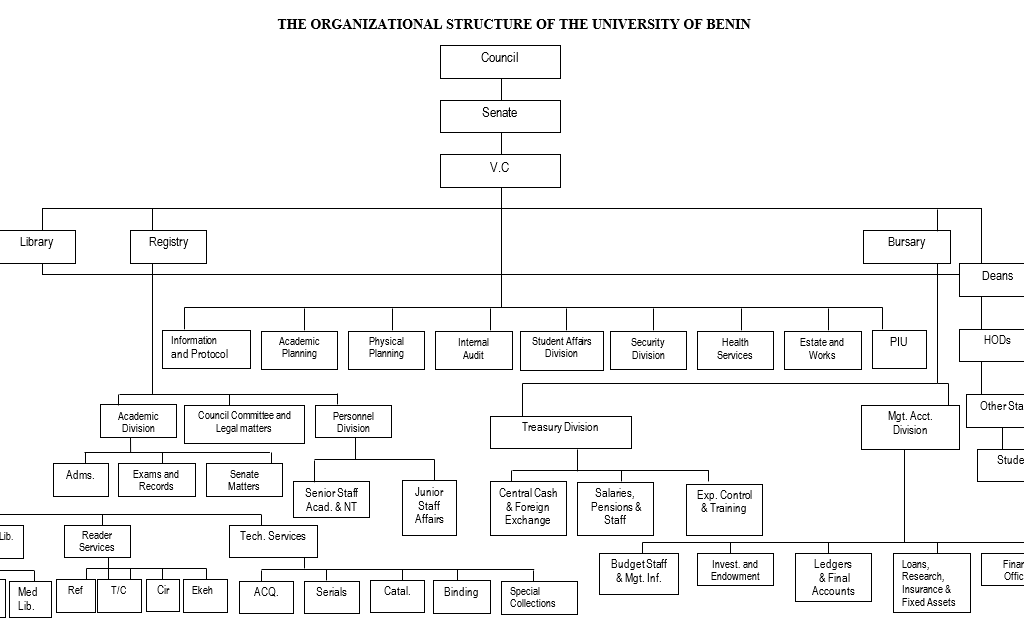ORGANIZATIONAL STRUCTURE OF THE UNIVERSITY The major components of the University Administration are the Council, Senate, Academic Units, the Vice Chancellor’s Office, the Registry, the Bursary, the Library and Estate and Works Department. The Council The Council is the governing body of the University and in that capacity, it has the general control of the policies made by the other components of the University. In addition, it has control over the finances and property of the University. At the moment, the Council of the University of Benin is composed of external members appointed by the Visitor to the University. Congregation, Senate and Alumni Representatives as well as the Vice Chancellor, Deputy Vice Chancellors and the Registrar who serves as Secretary. The University Bursar and the University Librarian are usually in attendance. The Senate The Senate is the highest academic policy-making body of the University. It is made up of Senior Academic Staff of the rank of Professors as well as Heads of Academic Departments/Institutes/Centres. The academic works of the University are distributed in such manner as may be prescribed by the Senate among the Faculties, Institutes and Centres or other teaching units which are under the control of the Boards of Studies. At the Faculty level, the Dean is the academic and administrative head. To facilitate the administration at that level, each Faculty is organized into specialized departments which are headed by senior academic staff. The line of communication therefore at the level ends up at the Dean’s Office from the level of the students through other staff to the heads of departments for purely administrative matters. The Faculty Boards of Studies superintend over academic matters in the Faculties. Specifically, the functions of each Board of Studies are: (a) to advise and report to Senate on all matters relating to the organization of education, teaching and research in the subjects of the Faculty or other teaching units, including curriculum and examination. (b) to consider the progress and conduct of students in a teaching unit and to report thereon to Senate; (c) to recommend to Senate persons for appointment as examiners; (d) to deal with any academic matters referred to it by Senate; and (e) to perform any other functions as may be prescribed. The Vice Chancellor’s Office The Vice Chancellor is empowered by the relevant Edict of the University to have authority or general function of directing the activities of the University; he is the Chief Executive and Academic Officer of the institution and ex-officio Chairman of Senate. In undertaking these functions, the Vice Chancellor relies on the other arms of the University Administration such as the Registry, Bursary, Library and the Academic Units. Beside, some specific operational units of the University are located within the ambit of the Vice Chancellor’s Office which make them answerable directly to the Vice Chancellor. These units which perform varying but complementary tasks include the Academic Planning Division, the Physical Planning Division, Internal Audit, Students Affairs Division and Security Division. Others are Information and Protocol Division, Legal Division, Project Implementation Unit, Health Services and Estate and Works Department. The Registrar’s Office The Registrar is the Chief Administrative Officer of the University. By virtue of that function, the Registrar is responsible to the Vice Chancellor for the day-to-day administrative work of the University. The Registrar is also the Secretary to Council, Senate and Congregation. To facilitate the works of the Registrar, the Registry is divided into three main units with several sub-sections each performing complementary function. The main units and their sub-sections are as follows: (a) The Academic Division. The Sub-sections are the Admissions, Senate and Examinations and Records. (b) The Personnel Division has the Senior Staff (Teaching and Non Teaching) and Junior Staff Affairs as its sub-sections. (c) The Council, Committee and Legal Division. This Division services the Council of the University and the Committee of the University and the Legal activities of the University. The Bursar’s Office The Bursar is the Chief Financial Officer of the University and he is responsible to the Vice Chancellor for the day-to-day administration and control of the financial affairs of the University. To facilitate the functions of the Bursar, the Bursary Department is sub-divided into two main Divisions with several sub-sections thus: (a) The Treasury Division: This unit oversees the activities of the central cash and foreign exchange; salaries, pensions, and staff training as well as expenditure control and passages sections. (b) The Management Accounting Division: The Budget, Statistics and Management Information; Investment and Endowment; Ledger and Financial Account; Loans, Research, Insurance and Fixed Assets as well as the finance offices operations, all fall under the purview the division. The University Library The University Librarian is responsible to the Vice Chancellor for the administration of the University Library and the coordination of all library services in the University. To facilitate the accomplishment of these tasks, the University Library is divided into three main sections thus: (a) The Administration Division: This section provides administrative support to the University Librarian as well as oversees the operations of the medical library. (b) The Reader Services Division: This section oversees the activities and operations of the Reference Unit. Text book collection, circulation and Ekehuan Campus Library operations. (c) The Technical Services Division: This unit oversees the library operations that have to do with acquisition, serials, cataloguing, bindery and special collections. It should however, be stressed that the existence of several sub-sections/units/departments in the academic units, Vice Chancellors Office, Registry, Bursary and the Library Departments of the University merely serve to involve several persons at different levels of University’s overall goals and aspirations of the institution. Besides, notwithstanding, the apparent operational autonomy of the major components of the University Administration, each component has simultaneous and direct functional relationship to the other and with the Vice Chancellor on regular basis. The functional relationships between the units enumerated above are shown in figure 1.


